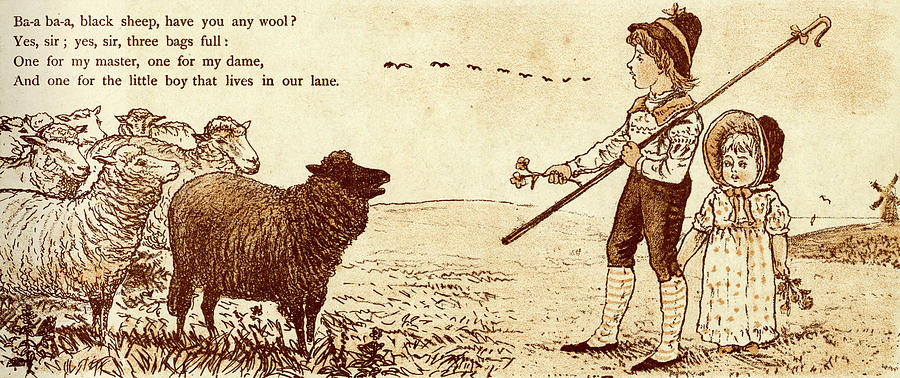In 1774, a chapbook entitled “Tommy Thumb’s Pretty Song Book” was first published in London, England. This book is now ultra rare, with only two copies remaining intact, one of which is is held by the British library. This book was the second part of a set which is described by the British Library catalogue as being the first ever compilation book of nursery rhymes in print. It was in this book, that the rhyme “Bah Bah Black Sheep” was first recorded in its original form:

The final line, however, was changed by 1765 to "the little boy who cried in the lane" and has since then been changed back to the original. As you can see, there’s not a great difference between the original lyrics and today’s lyrics, but the question is begged, what is it about? Is there any significance to the black sheep, or the three bags for the specific people?
Firstly, it should be noted that this rhyme is probably one of the most contentious of the nursery rhymes, with several schools in America and Australia banning it or even changing the lyrics to “rainbow sheep”, or adding an extra verse “baa baa white sheep” The most likely reason for this controversy is that in the 1980s, several experts suggested that it might be linked to the slave trade. This theory however, has no evidence to back it up, and so cannot be confirmed. New Scientist Magazine even ran a small article in 1986 which attempted to squash this rumour, reminding readers that the plantation slaves to whom the rhyme was being attributed tended to farm cotton, not wool, and also that the rhyme was likely a lot older than its 1744 publication, due to how rhymes were often passed mouth to mouth for many many years before being committed to publication.
Another often given explanation for this rhyme is that of wool tax. In 1275, Edward I put a tax on wool, which raised its price by up to a third of its value. This then, led to grievances amongst the shepherds and the “black sheep” could be explained as an expensive deviation, since it’s wool could not be dyed, limiting it to black cloth only and thus decreasing its value. In 1930, Katherine Thomas, a scholar, published a book named “The real personages of mother goose”. Here, she considered how, centuries later than the wool tax, the already present discontent amongst the poor was in fact exacerbated by the low wages paid to farmers and shepherds in the time of Henry VIII, and that in Exeter there was a rising of several thousand people. She concluded that the Master and the Dame could refer to the king and queen, or simply nobility of the time, and refers to “the little boy who cried in the lane” being unable to afford his own wool. Sadly, the lyric she quotes, of the little boy crying in the lane, is not the original, as seen above, and likely was found in the 1765, “Mother Goose Melody” version of the rhyme. Therefore, it is likely that she was unaware of this earlier version.
Further investigation into the wool trade in the 1700s, closer to the time of publication of this rhyme, shows that there was another event which would have directly affected it during the reign of William and Mary in the late 1600s, that is, the restriction of the exportation of wool from England and Ireland. This led to conflict amongst clothiers and wool merchants within England and Ireland, due to the fact that the Irish merchants took little notice of legislation, and continued to trade, angering the Englishmen. This however, is mere speculation as there is no evidence that this could have become part of the origin of this nursery rhyme. In much the manner of the research which has been done previously, this too is merely a possibility. Without evidence, it is impossible to say which of these events, if any influenced the origin of this rhyme.
So, the conclusion of this article is one which shows only speculation. This rhyme was first recorded in 1744, but it’s true origins are unknown. The most likely speculation gives it to the unhappy farmers or shepherds of the wool trade, but in truth, nobody really knows where it came from!
Sources Used.
"Ariadene", New Scientist, 1986, p. 80
Baring-Gould, William Stuart, and Ceil Baring-Gould, The Annotated Mother Goose, 4th edn (London, 1962)
"BBC News | EDUCATION | Nursery Rhyme Ban Scrapped", News.Bbc.Co.Uk, 2017 <http://news.bbc.co.uk/1/hi/education/600470.stm> [accessed 28 March 2017]
Irish Wool and Woollens. III.” The Irish Monthly, vol. 10, no. 108, 1882, pp. 414–428., www.jstor.org/stable/20496779.
Opie, Iona Archibald, and Peter Opie, The Oxford Dictionary Of Nursery Rhymes, 1st edn (Oxford, England: Clarendon Press, 1951)
Thomas, Katherine Ewes, "The Real Personages Of Mother Goose", 1930 <https://archive.org/details/in.ernet.dli.2015.75797> [accessed 28 March 2017]